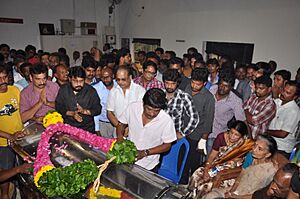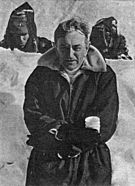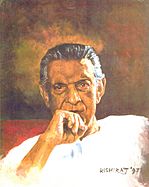Balu Mahendra facts for kids
Quick facts for kids
Balu Mahendra
|
|
|---|---|
 |
|
| Born |
Balanathan Benjamin Mahendran
19 May 1939 |
| Died | 13 February 2014 (aged 74) |
| Other names | Mahendra, Balu, Bala Mahendran |
| Citizenship | Sri Lankan Indian |
| Alma mater |
|
| Occupation | Draughtsman, literary editor, cinematographer, film director, screenwriter, film editor |
| Years active | 1971–2013 |
| Spouse(s) |
|
| Children | 1 |
Balanathan Benjamin Mahendran (born May 19, 1939 – died February 13, 2014), known as Balu Mahendra, was a famous filmmaker. He was from Sri Lanka and worked mostly in Tamil cinema in India. He was a talented cinematographer (who films movies), director, screenwriter (who writes movie stories), and film editor.
Balu Mahendra was known as an "auteur." This means he often wrote, filmed, and edited his own movies. He won many awards for his work. These include six National Film Awards and five Filmfare Awards South.
He loved photography and books from a young age. A school trip in Sri Lanka changed his life. He saw the filming of The Bridge on the River Kwai (1957) and decided to become a filmmaker. He studied at London University and first worked as a draughtsman. In 1966, he moved to India. He joined the Film and Television Institute of India (FTII) to study film photography.
After finishing his studies, he started working in Malayalam cinema in the early 1970s. He filmed over 20 movies as a cinematographer. In 1977, he directed his first movie, Kokila, in Kannada cinema. Over 36 years, he directed more than 20 films. He is seen as a trendsetter in Tamil cinema. Later in his career, he opened a film school in Chennai. It teaches about cinematography, directing, and acting. Balu Mahendra passed away in February 2014 after a heart attack.
Contents
Early Life and Film School
Balu Mahendra was born on May 19, 1939. His family lived in a village near Batticaloa, Sri Lanka. His father was a professor. Balu went to Methodist Central College and St. Michael's College National School. When he was a teenager, his teacher introduced him to films. He saw classic movies like Bicycle Thieves (1948) and Battleship Potemkin (1925).
A special moment happened when he was in sixth grade. He saw the making of David Lean's The Bridge on the River Kwai. This movie was filmed in Sri Lanka. Watching David Lean inspired Balu Mahendra greatly. He decided then that he wanted to become a filmmaker.
Balu Mahendra always loved fine arts and literature. After school, he went to London University. He earned a science degree with honors. He then returned to Sri Lanka. For a short time, he worked in Colombo as a draughtsman.
His strong interest in cinema led him to India in 1966. He joined the Film and Television Institute of India (FTII) in Pune. He chose to study cinematography because other courses were full. At FTII, he learned about world cinema. He watched films by famous directors like François Truffaut and Jean-Luc Godard. In 1969, Balu Mahendra graduated from FTII with a gold medal.
Film Career Highlights
Starting as a Cinematographer
After graduating, Balu Mahendra first tried to work in Sri Lankan Tamil cinema. But he didn't find success there. His first chance as a cinematographer came in 1971. It was for the Malayalam film Nellu. The director, Ramu Kariat, liked Balu's student film.
Nellu was filmed in 1971 but released in 1974. Before that, Balu worked on Maaya (1972). But his very first movie to be released was Panimudakku (1972). He continued to film many Malayalam movies. These included Sasthram Jayichu Manushyan Thottu (1973) and Chattakkari (1974).
Nellu, which was in color, won the Kerala State Film Award for Best Cinematography. Balu Mahendra won this award again for Prayanam (1975). Between 1971 and 1976, he worked as a cinematographer on about 20 films. Most of these were in Malayalam.
In 1977, he directed his first film, Kokila. This was a Kannada film about a "triangular love story." Balu Mahendra won a Karnataka State Film Award for Best Screenplay. He also won his first National Film Award for Best Cinematography for Kokila. The movie was popular and praised by critics. It was also very successful in Tamil Nadu.
Moving to Tamil Films
Even though he was Tamil, Balu Mahendra didn't work on a Tamil film until 1978. He was the cinematographer for Mahendran's first film, Mullum Malarum (1978). Balu Mahendra also helped with writing, casting, editing, and directing this film.
After Mullum Malarum, he decided to direct his second film. This time, it would be in Tamil. He called it Azhiyadha Kolangal (1979). He said this film was partly about his own life. Around this time, he also filmed the Telugu movie Sankarabharanam (1979). This movie became a huge success.
Balu Mahendra's third film as a director was Moodu Pani (1980). It was inspired by the 1960 film Psycho. For Moodu Pani, Balu Mahendra worked with Ilaiyaraaja for the first time. Ilaiyaraaja became his regular music composer after that.
In 1982, Balu Mahendra made Moondram Pirai. It starred Kamal Haasan and Sridevi. The film was about a teacher who cares for a girl with amnesia. It was a huge hit and ran for 300 days in theaters. Balu Mahendra won two National Film Awards for this film, including one for cinematography. That same year, he directed Olangal (1982) in Malayalam. This film was inspired by the novel Man, Woman and Child and was praised by critics. By the end of the year, Balu Mahendra won two Filmfare Awards South for directing Olangal and Moondram Pirai.
In 1983, Balu Mahendra entered Bollywood (Hindi cinema). He remade Moondram Pirai as Sadma. Kamal Haasan and Sridevi played their roles again. Balu Mahendra was nominated for a Filmfare Award for Best Story for Sadma. He became a well-known director in Hindi cinema. He also worked as the cinematographer for Mani Ratnam's first film, Pallavi Anu Pallavi, in Kannada.
Mainstream and Art Films
In the mid-1980s, Balu Mahendra focused on more popular films. His film Neengal Kettavai (1984) was a commercial movie. He made it to show critics he could direct popular films. The next year, he worked with Rajinikanth on Un Kannil Neer Vazhindal. This film was not a commercial success.
He then made the Malayalam film Yathra (1985). It starred Mammooty as a forest officer. This film was based on the Japanese movie The Yellow Handkerchief. Yathra was made with "artistic values" and was very successful. It ran for over 200 days and was the highest-grossing Malayalam film that year.
Critics were surprised when he made Rettai Vaal Kuruvi (1987). It was a full-length comedy film. It was based on the American film Micki and Maude. This movie is considered one of the best comedies in Tamil cinema from that time. It also influenced his later films like Marupadiyum (1993) and Sathi Leelavathi (1995). These films explored similar themes.
Towards the end of the 1980s, Balu Mahendra made two low-budget films. These were Veedu (1988) and Sandhya Raagam (1989). Veedu was about a middle-class woman trying to build a house. Sandhya Raagam was about "old age." Veedu won two National Film Awards, including Best Regional Film. Sandhya Raagam won the National Film Award for Best Film on Family Welfare two years later. Balu Mahendra said these films were tributes to his mother and father. He considered them his best works.
In 1992, Balu Mahendra made Vanna Vanna Pookkal. This film ran for 100 days and won the "Best Regional Film" award. The next year, he remade Mahesh Bhatt's Arth in Tamil as Marupadiyum. He felt this story was close to his own life. Then, in 1995, he made the comedy Sathi Leelavathi, produced by Kamal Haasan.
In 1996, he returned to Bollywood with Aur Ek Prem Kahani. This was a remake of his Kannada film Kokila. He then made Raman Abdullah (1997). This film was about the friendship between two friends from different religions. The film faced some production issues and did not do well. After Raman Abdullah, Balu Mahendra took a break from films. During this time, he made Kathai Neram, a TV series based on short stories. It aired on Sun TV.
Final Years in Film
After a five-year break, Balu Mahendra returned with Julie Ganapathi (2003). This film was based on the thriller novel Misery by Stephen King. Balu Mahendra said Julie Ganapathi was similar to his earlier films Moondram Pirai (1982) and Moodu Pani (1980). Critics praised the film as a good thriller. However, it was not a commercial success.
For his next film, Adhu Oru Kana Kaalam (2005), he cast Dhanush in the main role. This film was loosely based on his own Malayalam film Yathra (1985). Some critics found the film disappointing.
In 2007, he opened a film school in Chennai called "Cinema Pattarai." It teaches courses in cinematography, directing, and acting. After another break, he made a comeback with Thalaimuraigal (2013). This film was special because he also acted in it for the first time. He also wrote, directed, edited, and filmed it. The movie was about the relationship between an old man and his grandson. Balu Mahendra's acting was highly praised. The Hindu newspaper said the film was a "concrete step" towards competing globally. Even though critics loved it, the film did not earn much money. It won the Nargis Dutt Award for Best Feature Film on National Integration at the 61st National Film Awards.
Personal Life

Balu Mahendra was married three times. His first wife was Akhileshwari, and they had a son. He was later married to actress Shoba, who passed away in 1980. In 1998, he married actress Mounika. He publicly announced their marriage in 2004.
Balu Mahendra suffered a heart attack on February 13, 2014. He was taken to Vijaya Hospital in Chennai. He passed away after six hours of cardiac arrest. Many people from the Indian film industry shared their sadness. The Tamil film community paid their respects at his film school in Saligramam, Chennai. They decided not to work the next day to honor him. Balu Mahendra's final rites were held at Porur crematorium on the same day.
Style and Legacy
As a photographer, Balu Mahendra was inspired by Néstor Almendros and Michael Chapman. He also admired Ashok Kumar among his peers. Balu Mahendra believed that good cinematography should be very close to the story.
As a filmmaker, he followed the realistic style of Satyajit Ray and Vittorio De Sica. He was drawn to realistic cinema after watching Ray's Pather Panchali (1955). He was one of the first filmmakers to bring "naturalism" to Tamil cinema in the 1970s. He usually filmed, wrote, and edited all his movies himself. His films were known for their strong "visual appeal" and few characters. Many of his films explored complex human relationships. They often showed women as strong characters.
Balu Mahendra was praised for both his cinematography and directing skills. He was called "one of the finest cinematographers of Indian cinema." He was a pioneer in using innovative color in South India. Subrata Mitra, Satyajit Ray's cinematographer, even gave Balu Mahendra a viewfinder as a sign of respect. Fellow cinematographer Madhu Ambat said Balu Mahendra brought fame to cameramen from FTII. He also noted that Balu Mahendra used "romantic realism" very well. He was known for using "natural lighting" in his films. Kamal Haasan said Balu Mahendra balanced art films and popular cinema.
He inspired many actors and filmmakers. These include Mani Ratnam, Kamal Haasan, and Sripriya. He also mentored new directors like Bala, Ameer, Vetrimaaran, Ram, and Seenu Ramasamy. Cinematographers like Santosh Sivan, Ravi K. Chandran, and K. V. Anand were also inspired by him. Sadly, the original film negatives of some of his famous films are now lost. These include Moodu Pani, Veedu, and Sathi Leelavathi.
Working with Ilaiyaraaja
Balu Mahendra directed 23 films in 5 languages. He worked with music composer Ilaiyaraaja on 21 of these films. Their partnership was very strong. Ilaiyaraaja created many hit songs for Balu Mahendra's movies. Balu Mahendra always chose Ilaiyaraaja, even for his Hindi remakes.
A great example of their teamwork is the song "Thumbi Vaa." This superhit song was from the 1982 Malayalam film Olangal. They used this song five times in four different languages. It was also featured in the film Paa and in one of Ilaiyaraaja's concerts.
Awards and Nominations
| Year | Award | Category | Work(s) | Result |
|---|---|---|---|---|
| 1974 | Kerala State Film Award | Best Cinematography (colour) | Nellu | Won |
| 1975 | Kerala State Film Award | Best Cinematography (black-and-white) | Prayanam, Chuvanna Sandhyakal | Won |
| 1977 | National Film Awards | Best Cinematography (black-and-white) | Kokila | Won |
| 1978 | Nandi Awards | Best Cinematographer | Manavoori Pandavulu | Won |
| 1979 | Filmfare Awards South | Best Director (Tamil) | Azhiyatha Kolangal | Nominated |
| 1982 | National Film Awards | Best Cinematography (Colour) | Moondram Pirai | Won |
| Filmfare Awards South | Best Director (Tamil) | Won | ||
| Best Director (Malayalam) | Olangal | Won | ||
| Karnataka State Film Awards | Best Cinematography | Pallavi Anupallavi | Won | |
| 1983 | Filmfare Awards | Best Story | Sadma | Nominated |
| 1985 | Filmfare Awards South | Best Director (Malayalam) | Yathra | Won |
| 1986 | Kerala State Film Award | Kerala State Film Award for Best Film with Popular Appeal and Aesthetic Value | Yathra | Won |
| Nandi Awards | Best Cinematography | Nireekshana | Won | |
| Filmfare Awards South | Best Director (Telugu) | Nireekshana | Nominated | |
| 1987 | National Film Awards | Best Feature Film in Tamil | Veedu | Won |
| 1988 | Filmfare Awards South | Best Director (Tamil) | Veedu | Won |
| 1989 | National Film Awards | Best Film on Family Welfare | Sandhya Raagam | Won |
| 1991 | National Film Awards | Best Feature Film in Tamil | Vanna Vanna Pookkal | Won |
| 2013 | National Film Awards | Best Feature Film on National Integration | Thalaimuraigal | Won |
| 2013 | 61st Filmfare Awards South | Best Tamil Director | Thalaimuraigal | Nominated |
| Lifetime Achievement Award – South |
|
Won | ||
| 2014 | 8th Vijay Awards | Vijay Award for Contribution to Tamil Cinema |
|
Won |
| 2017 | Tamil Nadu State Film Awards | Best Story Writer | Thalaimuraigal | Won |
Filmography
As Director
- Kokila (1977; Kannada film)
- Azhiyadha Kolangal (1979)
- Moodu Pani (1980)
- Moondram Pirai (1982)
As Director, Cinematographer & Editor
- Olangal (1982; Malayalam film)
- Oomakkuyil (1983; Malayalam film)
- Sadma (1983; Hindi film)
- Neengal Kettavai (1984)
- Un Kannil Neer Vazhindal (1985)
- Yathra (1985; Malayalam film)
- Nireekshana (1986; Telugu film)
- Rettai Vaal Kuruvi (1987)
- Veedu (1988)
- Sandhya Raagam (1989)
- Vanna Vanna Pookkal (1992)
- Chakravyuham (1992)
- Marupadiyum (1993)
- Sathi Leelavathi (1995)
- Aur Ek Prem Kahani (1996; Hindi film)
- Raman Abdullah (1997)
- En Iniya Ponnilave (2001)
- Julie Ganapathy (2003)
- Adhu Oru Kana Kaalam (2005)
- Thalaimuraigal (2013; also actor)
As Cinematographer
- Panimudakku (1972; Malayalam film)
- Maaya (1972; Malayalam film)
- Nirthasala (1972; Malayalam film; one song)
- Sasthram Jayichu Manushyan Thottu (1973; Malayalam film)
- Abhimanavanthulu (1973; Telugu film)
- Kaliyugam (1973; Malayalam film)
- Chukku (1973; Malayalam film)
- Nellu (1974; Malayalam film)
- Rajahamsam (1974; Malayalam film)
- Chattakkari (1974; Malayalam film)
- Jeevikkan Marannu Poya Sthree (1974; Malayalam film)
- Makkal (1974; Malayalam film)
- Raagam (1975; Malayalam film)
- Prayanam (1975; Malayalam film)
- Tourist Bungalow (1975; Malayalam film)
- Chuvanna Sandhyakal (1975; Malayalam film)
- Anuraagaalu (1975; Telugu film)
- Cheenavala (1975; Malayalam film)
- Missi (1976; Malayalam film)
- Ponni (1976; Malayalam film)
- Chennaaya Valarthiya Kutty (1976; Malayalam film)
- America Ammayi (1976; Telugu film)
- Tharam Marindi (1977; Telugu film)
- Panthulamma (1977; Telugu film)
- Lambadolla Ramadasu (1978; Telugu film)
- Mullum Malarum (1978)
- Manavoori Pandavulu (1978;Telugu film)
- Sommokadidhi Sokokadidhi (1979; Telugu film)
- Ulkatal (1979; Malayalam film)
- Sankarabharanam (1980; Telugu film)
- Kaliyuga Ravanasurudu (1980; Telugu film)
- Echchil Iravugal (1982)
- Pallavi Anu Pallavi (1983; Kannada film)
- Urangatha Ninaivugal (1983)
Television
- Kathai Neram (2000)



